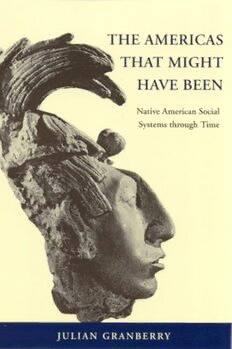
The Americas That Might Have Been: Native American Social Systems through Time PDF
Preview The Americas That Might Have Been: Native American Social Systems through Time
The Americas That Might Have Been The Americas That Might Have Been Native American Social Systems Through Time Julian Granberry the university of alabama press Tuscaloosa Copyright © 2005 The University of Alabama Press Tuscaloosa, Alabama 35487-0380 All rights reserved Manufactured in the United States of America Typeface: AGaramond and Triplex Condensed Serif ∞ The paper on which this book is printed meets the minimum requirements of American National Standard for Information Science—Permanence of Paper for Printed Library Materials, ANSI Z39.48-1984. Library of Congress Cataloging-in-Publication Data Granberry, Julian. The Americas that might have been : Native American social systems through time / Julian Granberry. p. cm. Includes bibliographical references and index. ISBN 0-8173-1457-1 (cloth : alk. paper) — ISBN 0-8173-5182-5 (pbk. : alk. paper) 1. Indians—First contact with Europeans. 2. Indians—Transatlantic in®uences. 3. Indians— Colonization. 4. America—Discovery and exploration. 5. America—Colonization. 6. Europe—Colonies—America. I. Title. E59.F53G73 2005 303.48′2′08997—dc22 2004019072 Cover photo: K’inich Janaab’ Pakal I, King of the Maya Kingdom of B’aakal (Palenque), b. 23 March 603–d. 28 August 683, reigned 615–683. Photo by Irmgard Groth-Kimball (Thames & Hudson). Courtesy of Thames & Hudson Ltd. OVERTURE Dreaming alone of yet uncharted seas Beyond the western curve, Where, in the womb of the ocean, Lay continents undreamed and consequence Past all imagining: Dreaming alone, Cristóforo Colombo Struck forth his vision. The dream becomes the act: with signal vigor This ¤rst Conquistador Ripped from the western sea the riotous wealth And squalor of the future centuries And showed, in his myopic prescience, The shape of our modern world. —Columbus: Dream and Act A Tragic Suite, by Foster Provost Contents List of Figures ix Preface xi Introduction: The Whys and Wherefores 1 PART I. IN THE BEGINNING 21 1. Men Out of Asia 23 2. America 1492 33 PART II. THE INNER MAN 39 3. Native Philosophies of Life 41 4. Unitary Norms: The Asian Perspective 46 5. The Dualistic View: The European Norm 52 6. The Trinary Compromise: The Near Eastern Norm 62 PART III. THE MATRIX OF LIVES 69 7. The Empire of Tawantinsuyu 71 8. The Empire of the Méxica 84 9. The Maya Kingdoms 95 10. The Mississippian Cities and Towns 107 11. The Pueblo Towns 117 12. The Taíno Kingdoms 127 PART IV. THE FUTURE OF THE PAST 139 13. Hemispheric-Internal Relationships in the Twenty-¤rst Century: The Inner Design 141 14. Commerce and Discovery of the Old World 156 15. International Alliances and Interaction in the Twenty-¤rst Century: The Outer Scheme 171 viii contents Epilogue: The First Baktun 178 References 181 Index 199 Figures 1 Generational Kin Terminologies 11 2 Descriptive Kin Terminologies 12 3 Lineal Kin Terminologies 12 4 Merging Kin Terminologies 13 5 Skewed Merging Kin Terminology 1 14 6 Skewed Merging Kin Terminology 2 14 7 Major Native American Societies, 1492 35 8 The World’s Unitary States, 2004 47 9 The World’s Dualistic States, 2004 54 10 The World’s Trinary States, 2004 63 11 The Empire of Tawantinsuyu in 1532 74 12 The Aztec Empire in 1519 85 13 Maya Kingdoms of the Classic Period (ca. a.d. 250–900) 97 14 Maya Kingdoms at the Time of Spanish Intervention (1528) 101 15 Mississippian Cities of the Classic Period (a.d. 1000–1400) 109 16 Pueblo Towns in 1492 118 17 Taíno Kingdoms of Hispaniola in 1492 131 18 New World Polities and Alliances, 2004 143 19 Major Surface Ocean Steering Currents 164 20 World Trade Alliances in the Twenty-¤rst Century 168 21 International Alliances of New World Polities in the Twenty-¤rst Century 176
